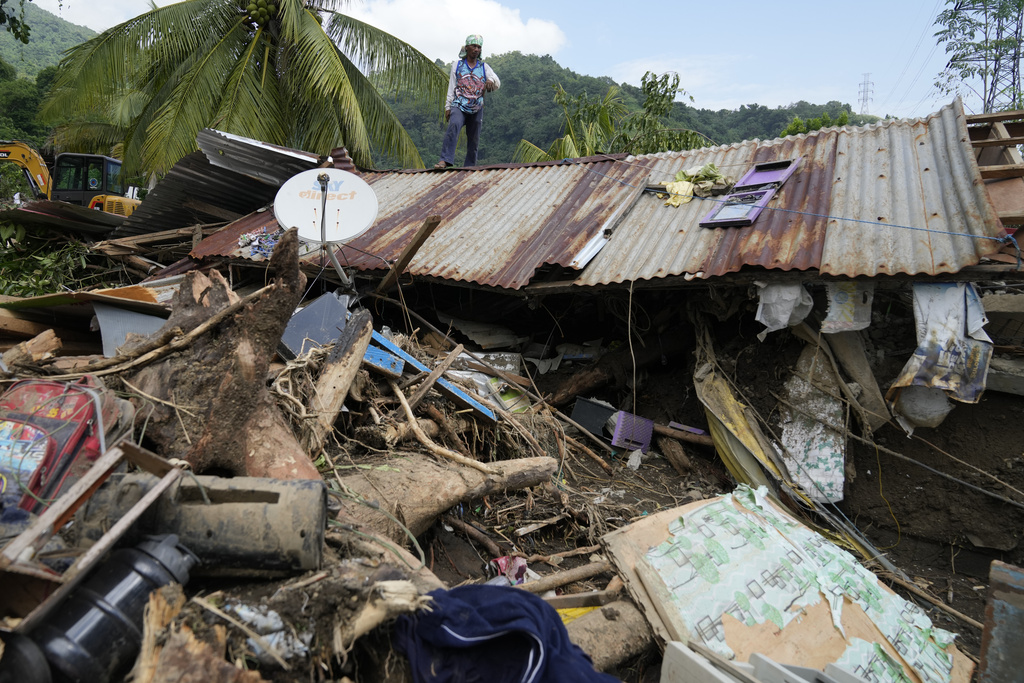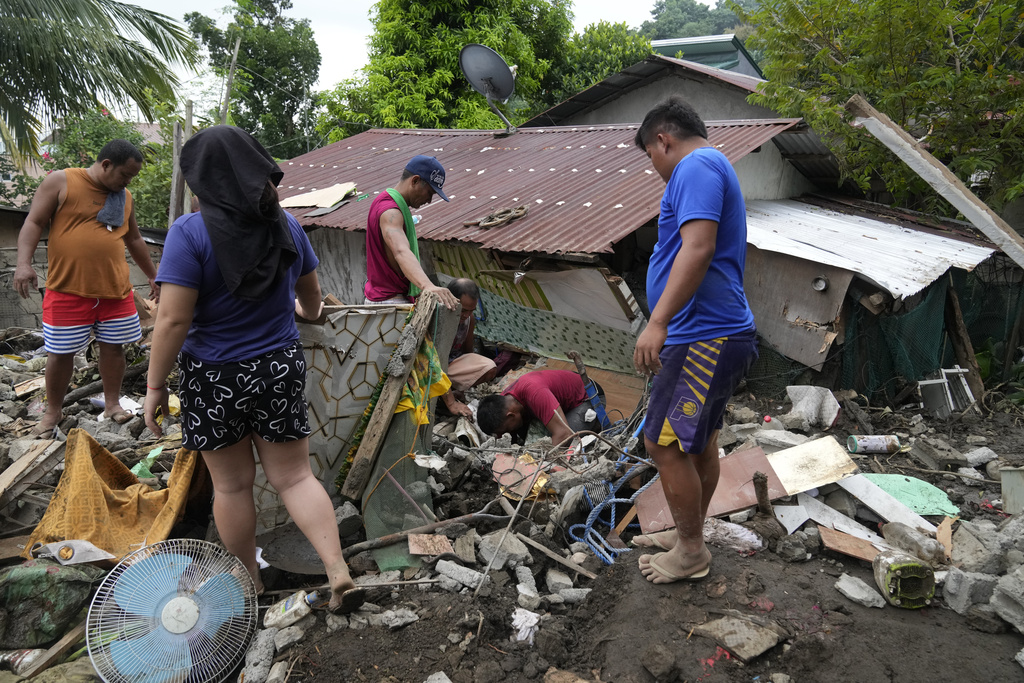Death Toll Nears 130 After Devastating Philippine Storm Trami \ Newslooks \ Washington DC \ Mary Sidiqi \ Evening Edition \ Tropical Storm Trami has devastated the Philippines, leaving 130 people dead or missing due to severe flooding and landslides. President Ferdinand Marcos visited affected areas, emphasizing the need for major flood control infrastructure. The storm displaced millions, and authorities warn of a possible U-turn by Trami, raising additional safety concerns.

Tropical Storm Trami Devastation in the Philippines Quick Looks
- The storm has left at least 85 dead and 41 missing, with the toll expected to rise.
- President Marcos inspected damage, pledging to prioritize comprehensive flood control measures.
- Heavy rainfall overwhelmed infrastructure, triggering massive landslides and leaving many areas isolated.
- Over 5 million people were affected, with nearly 500,000 seeking shelter in evacuation centers.
- Authorities remain on high alert as meteorologists warn of a possible U-turn by Trami next week.
Deep Look
The Philippines is reeling from the catastrophic impact of Tropical Storm Trami, which swept across the country late last week, bringing relentless rains, massive flooding, and deadly landslides that have left nearly 130 people dead or missing. As emergency teams worked tirelessly to locate survivors amid the destruction, the gravity of Trami’s impact continues to unfold, with damage assessments and rescue operations ongoing across northern Luzon, the most affected region. President Ferdinand Marcos visited hard-hit areas on Saturday, pledging a comprehensive overhaul of the nation’s flood control infrastructure to prepare for similar future events, which are becoming more frequent and severe due to climate change.
Tropical Storm Trami, which exited the Philippines on Friday, is one of the most lethal storms to hit the Southeast Asian nation this year, displacing millions and prompting President Marcos to mobilize extensive disaster relief efforts. Despite evacuation protocols, the intensity of the storm overwhelmed flood defenses in many provinces. The Philippine Atmospheric, Geophysical, and Astronomical Services Administration (PAGASA) reported that some areas received rainfall levels equivalent to one to two months’ worth in a single day. These conditions triggered widespread flooding and landslides, isolating communities, washing out roads, and damaging critical infrastructure.
Devastation Across Communities and Emotional Toll
The aftermath of Trami has been felt deeply in communities across northern Luzon, with Talisay in Batangas province bearing the brunt of landslide damage. In one instance, dozens of emergency responders, including police and firefighters, worked tirelessly on Saturday to recover two remaining missing villagers in the lakeside town. Search teams used backhoes and sniffer dogs to aid in locating victims, underscoring the challenging and often dangerous work required in disaster zones.
In a tragic moment that highlighted the storm’s emotional toll, a father who had been waiting for news about his missing 14-year-old daughter stood by as rescue workers brought her remains up from a mud-covered mound. Grief-stricken, he followed police officers who carried the body in a black bag down a debris-strewn village path, overwhelmed by sorrow. In a nearby gymnasium, turned into a temporary morgue, a row of white coffins held the remains of residents found beneath the landslides. The local community, now marked by loss, is united in grief as they mourn neighbors, friends, and family members lost to the disaster.
President Marcos acknowledged the unprecedented volume of water that overwhelmed flood defenses, stating, “The water was just too much.” He highlighted the urgent need for reinforced flood control and disaster management infrastructure, recognizing the increasing threat posed by climate change. Marcos emphasized that his administration would prioritize building more resilient infrastructure capable of withstanding such intense rainfall and flood conditions. “We’re not done yet with our rescue work,” he said, explaining that certain flooded and isolated areas remained unreachable even to large emergency vehicles.
Government Response and Future Preparedness
With the widespread devastation underscoring the need for climate-resilient infrastructure, President Marcos convened an emergency Cabinet meeting to discuss immediate and long-term responses to the crisis. Philippine meteorologists expressed concerns over Trami’s potential U-turn, as high-pressure winds in the South China Sea could force the storm back toward the country. Trami is also projected to hit Vietnam over the weekend, though its trajectory remains uncertain. Marcos instructed government agencies to prepare for all contingencies, warning communities to stay vigilant and heed local advisories in case of renewed threats from Trami.
The Philippine government enacted a series of emergency measures to keep residents safe, including closing schools, government offices, and businesses. These closures were extended through Friday, marking the third consecutive day of such precautions on the main island of Luzon. Ferry services between islands were also suspended to prevent accidents in stormy waters, resulting in thousands of stranded passengers. By Saturday, weather conditions had improved, allowing cleanup and relief efforts to begin in some areas. Volunteers and local officials began clearing debris, restoring essential services, and providing aid to families affected by the disaster.
The Philippines’ Ongoing Battle with Typhoons
The Philippines, an archipelago vulnerable to tropical cyclones due to its position between the Pacific Ocean and the South China Sea, regularly faces such devastating storms, with around 20 typhoons or tropical storms making landfall each year. The impact of these storms is intensified by climate change, which increases the frequency and severity of tropical cyclones in the region. The country’s susceptibility was exemplified in 2013 when Typhoon Haiyan, one of the strongest tropical cyclones ever recorded, left over 7,300 people dead or missing and wiped out entire villages.
As the threat from climate-induced extreme weather grows, so too does the need for a more robust national disaster response and prevention system. President Marcos’ commitment to prioritizing large-scale flood control projects is seen as an essential step toward creating a more resilient infrastructure capable of withstanding intense storms. However, experts emphasize that meaningful progress will require substantial investment, strategic planning, and interagency cooperation to ensure that flood controls can protect lives and prevent widespread displacement.
Resilience and Recovery
In the wake of Tropical Storm Trami, the road to recovery for Filipino communities will be lengthy, with much work required to rebuild and rehabilitate affected regions. For families who have lost loved ones, homes, and livelihoods, the tragedy serves as a sobering reminder of the unpredictable nature of natural disasters and the toll they take on vulnerable populations. Nevertheless, the resilience of Filipino communities, strengthened through repeated recovery efforts, remains a testament to their spirit and determination.
Looking Ahead
With the potential return of Tropical Storm Trami still looming, government agencies are on high alert. Authorities have urged citizens to stay informed about storm updates and prepare for additional disruptions if the storm changes direction. The Philippine government’s response in the coming weeks will be critical, not only in managing immediate rescue and recovery needs but in laying the groundwork for future resilience as storms intensify.
Death Toll Nears Death Toll Nears Death Toll Nears







